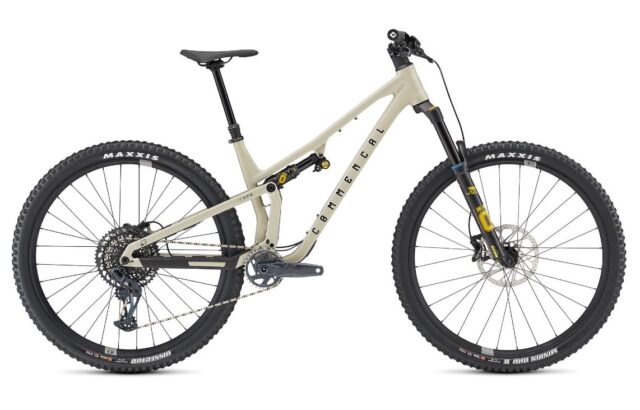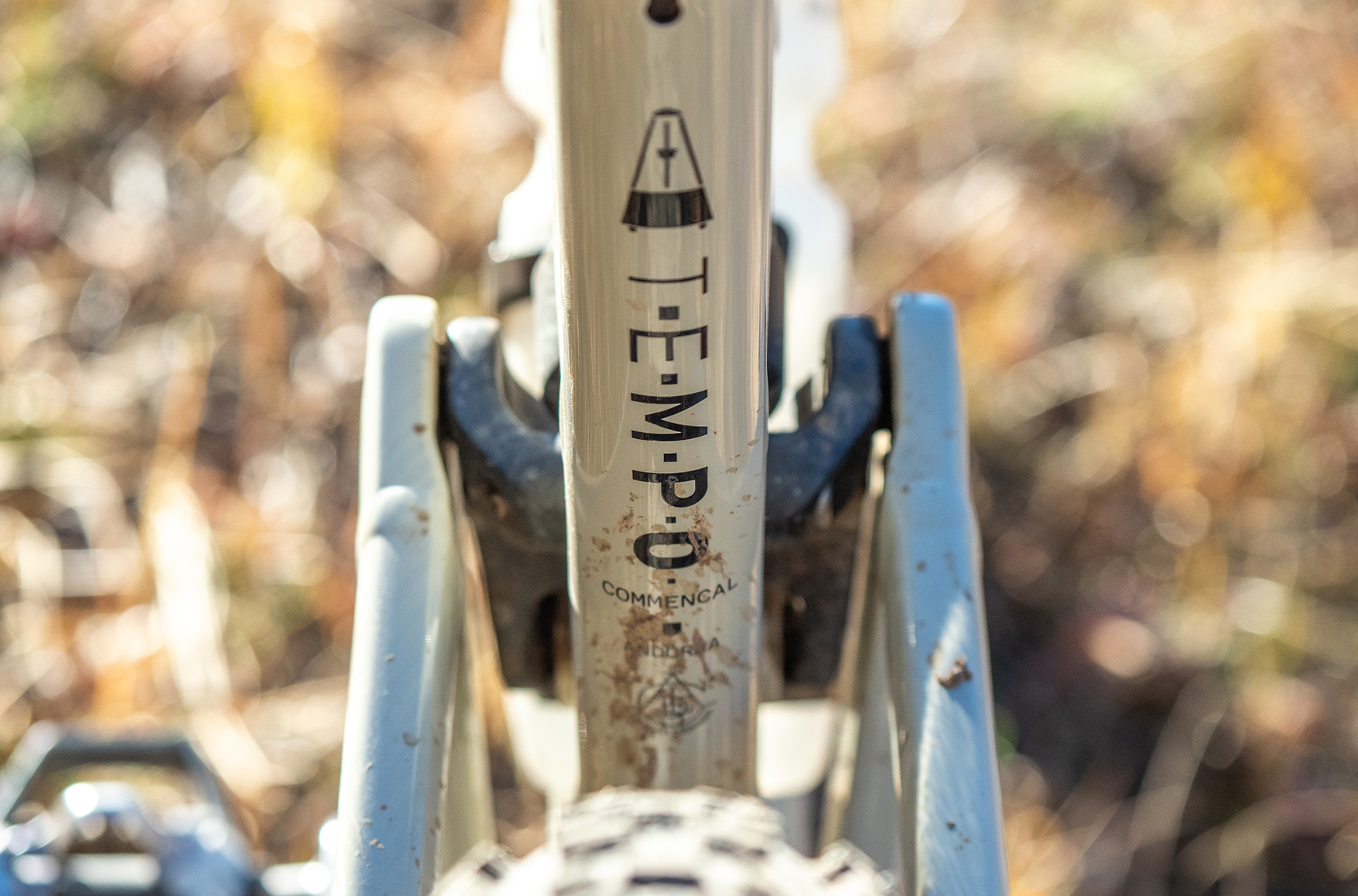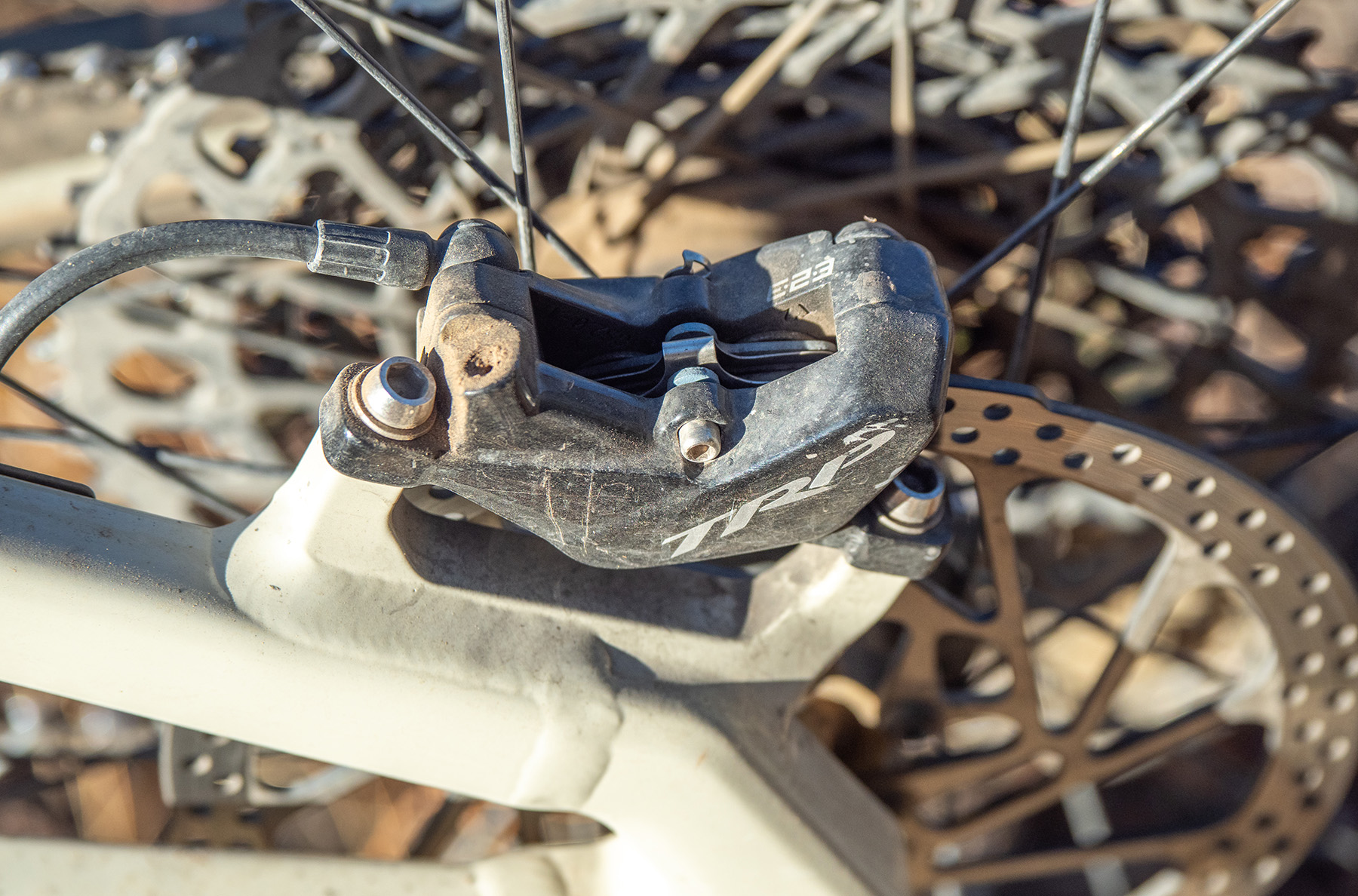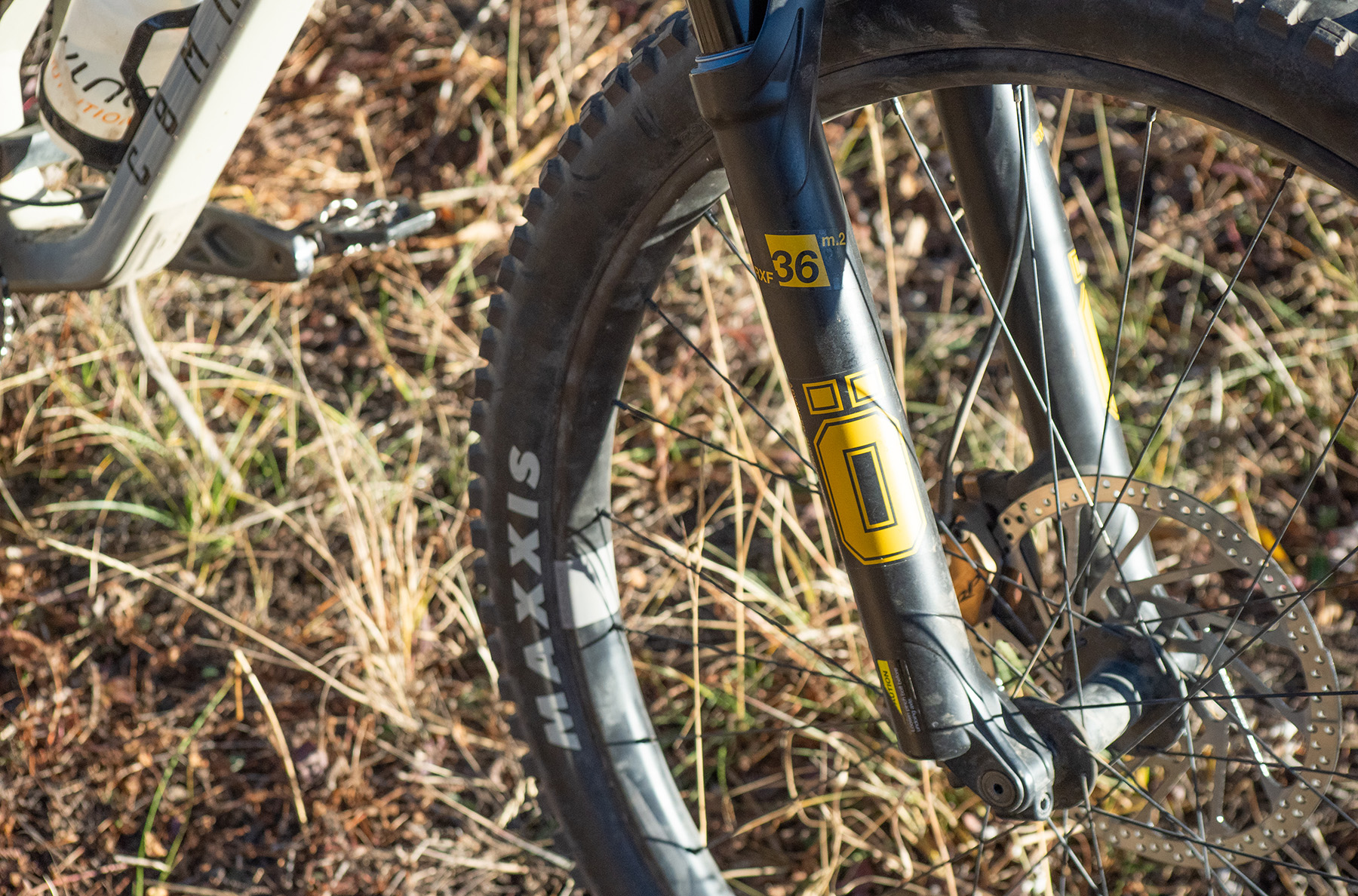Commencal T.E.M.P.O.
Wheel Size: 29’’
Travel: 125 mm rear / 140-150 mm front
Geometry Highlights (140mm fork):
- Sizes offered: S, M, L, XL
- Headtube angle: 65.5°
- Seat tube angle: 76.5°
- Reach: 470 mm (size Large)
- Chainstay length: 435 mm for S/M and 440mm for L/XL
Frame Material: Aluminum
Price:
- Frame only, w/o shock: $1,800
- Complete bikes: $3,200 — $6,500

Intro
Commencal isn’t exactly known for lightweight bikes, or Cross Country bikes for that matter. Their brand recognition is rooted in all mountain bruisers and World Cup-winning Downhill bikes. With the introduction of the T.E.M.P.O., Commencal is entering the increasingly competitive short travel trail bike segment and staying true to their heritage, they’re positioning it on the more aggressive side of things, as demonstrated by their release video with Hugo Frixtalon.
The Frame
Commencal hasn’t had a carbon model in their lineup in a long time now, and despite moving into a shorter-travel category, they’ve stuck with their preferred aluminum. While the use of aluminum from a company that only uses aluminum is not particularly newsworthy, the departure from their existing linkage-driven single pivot suspension design to an entirely new virtual pivot point design certainly is. This new design is called the Virtual Contact System, and delivers 125mm of travel, with a stated emphasis on pedaling efficiency, though Commencal also talks a fair bit about maintaining bump absorption capability and comfort as well. Particulars of the suspension kinematics aren’t stated.
In short, the suspension is a dual mini-link arrangement, with both links largely hidden behind the swingarm. The main pivot axles will resist loosening with an expandable collet, the bottom bracket is a PF92, and the brake mount takes a 180 mm rotor directly, or can be adapted up to 200 mm.

Fit & Geometry
The T.E.M.P.O. comes in only four evenly-spaced sizes, which Commencal states will accommodate riders from 5’2” to 6’11”. While that seems reasonable for the Small frame, the XL has a not-super-long 490 mm reach and 642 mm effective top tube, so we suspect that the upper end of Commencal’s suggested sizing is a bit optimistic.
The 65.5° head angle is fairly typical for the new crop of aggressive short-travel trail bikes, and the 76.5° seat tube angle also seems sensible for this sort of bike. The chainstays are partially size specific with the Small and Mediums coming in at 435mm and the Large and XLs at 440mm — both those numbers slot almost exactly into what we’re seeing from its competitors. All in all, the numbers, while progressive, are also very much the norm in this category now.
The Builds
The T.E.M.P.O. is available in seven complete builds with pricing starting at $3,200 and topping out at $6,500. Each of the builds has a couple of color options except the top-spec T-Type and LTD kits which are only available in black and white, respectively.
Frame-only options are available for $1,800 which, interestingly, doesn’t include a shock. A variety of options are available for an upcharge, though, interestingly, the Fox DPS shock that’s spec’d on a number of the complete builds isn’t an option for the frames.

- Drivetrain: SRAM SX Eagle
- Brakes: TRP Trail Evo
- Fork: RockShox Pike, 140mm
- Shock: RockShox Deluxe Select +
- Wheels: Spank Spike Race 33 rims w/ Formula hubs
- Dropper Post: KS Rage-1 (S: 150 mm; M: 170 mm; L–XL: 190 mm)
- Drivetrain: Shimano SLX
- Brakes: TRP Trail Evo
- Fork: Fox 34 Performance
- Shock: Fox Float DPS Performance
- Wheels: DT Swiss XM481 rims w/ Formula hubs
- Dropper Post: KS LEV Integra (S: 150 mm; M: 175 mm; L–XL: 200 mm)
- Drivetrain: SRAM GX Eagle
- Brakes: TRP Trail Evo
- Fork: Ohlins RFX 36 M.2
- Shock: Ohlins TTX1 Air
- Wheels: Crankbrothers Synthesis Enduro Alloy w/ Industry Nine 1/1 hubs
- Dropper Post: KS LEV Integra (S: 150 mm; M: 175 mm; L–XL: 200 mm)
- Drivetrain: SRAM GX Eagle
- Brakes: Shimano XT 2-piston
- Fork: Fox 34 Factory Grip2
- Shock: Fox Float Factory
- Wheels: DT Swiss XM 1700 w/ DT Swiss 350 Hubs
- Dropper Post: Fox Transfer Factory (S: 150 mm; M: 175 mm; L–XL: 200 mm)
- Drivetrain: SRAM GX Eagle
- Brakes: TRP DH-R Evo
- Fork: Fox 34 Factory Grip2
- Shock: Fox Float DPS Factory
- Wheels: Industry Nine Enduro S w/ Industry Nine Hydra Hubs
- Dropper Post: Fox Transfer Factory (S: 150 mm; M: 175 mm; L–XL: 200 mm)
- Drivetrain: SRAM X01 Eagle
- Brakes: Shimano XT 2-piston
- Fork: Fox 34 Factory Grip2
- Shock: Fox Float Factory
- Wheels: DT Swiss XMC 1501 w/ DT Swiss 240 Hubs
- Dropper Post: Fox Transfer Factory (S: 150 mm; M: 175 mm; L–XL: 200 mm)
- Drivetrain: SRAM X0 Eagle Transmission
- Brakes: Shimano XT 2-piston
- Fork: Fox 36 Factory Grip2 (150 mm)
- Shock: Fox Float X Factory
- Wheels: DT Swiss XMC 1501 w/ DT Swiss 240 Hubs
- Dropper Post: Fox Transfer Factory (S: 150 mm; M: 175 mm; L–XL: 200 mm)
And if none of these builds catch your fancy, Commencal offers a new super cool a-la-carte option. This gives you incredible customization potential, all the way down to what type of seat collar you want. Higher spec parts like SRAM AXS or Enve’s AM30 wheelset are also in there, but the pricing on the customized builds is, perhaps understandably, not as impressive as that on Commencal’s standard builds. And interestingly, you can even choose to have your a-la-carte built T.E.M.P.O. shipped un-assembled and save yourself $150.
Some Questions / Things We’re Curious About
(1) Commencal hasn’t listed weights for complete bikes, but a bit of math based on the frame weight puts it in the 30lb-plus category, which isn’t exactly light. To be fair, Commencal is definitely positioning the T.E.M.P.O. at the more aggressive end of the spectrum for its travel range, but how will that add up on the trail?
(2) And how will the new suspension platform perform?
FULL REVIEW
With a history more focused on gravity-oriented bikes with less of an emphasis on low weights, we were very interested to see what Commencal’s shortest travel Trail bike has to bring to the table. We’ve spent the last few months riding the T.E.M.P.O on a variety of trails, and we now have a good grasp on how this bike performs and where it sits in its class of shorter-travel Trail bikes.

Fit and Sizing
Dylan Wood (5’10.5”, 155 lbs / 179 cm, 70 kg): Being 5’10.5” (179 cm), I’m a bit on the shorter side of Commencal’s recommendations for the Large T.E.M.P.O. Despite that, I found it to offer a very comfortable and functional fit for me. With a reach of 470 mm on the size Large T.E.M.P.O., it is certainly not above average for most “Large” bikes these days, and within my typically preferred range of a 470-480 mm reach.
I found the seating climbing position to be very comfortable aboard the T.E.M.P.O., with the reasonable 76.6º effective seat tube creating a pretty average top tube length of 621.5 mm. I found that this fit allowed me to pedal casually from a more upright torso position on flatter trails, as well as hunch over the bars from a more aggressive position to keep the front wheel weighted on steeper climbs.
I also found that the T.E.M.P.O.’s 470 mm reach allowed for enough room to maneuver around the bike, without feeling too cramped. Having spent time on bikes with reach numbers around 470-485 mm, it does feel slightly on the smaller side, but not too small by any means. I definitely wouldn’t want to go any smaller, though, and while Commencal’s size chart has my height compatible with either the Medium or Large T.E.M.P.O., I definitely think that the Large was the right size for me.
Simon Stewart (6’, 170 lb / 183 cm, 77.1 kg): I also found the T.E.M.P.O. to be a good fit, and didn’t require any parts swapping to dial things in. The 470 mm reach is definitely on the low end of my preferred range, but the 76.6º effective seat tube angle kept it from feeling too compact — had the effective seat tube angle been closer to 78º, I think I may have felt a bit cramped under seated pedaling. I’m almost always a size Large in bikes that use that sizing scheme, but when the reach is on the shorter side I do take a peek at the XLs. The T.E.M.P.O.’s reach numbers go up in 20 mm increments which puts the XL at 490 mm, and that’s a bit longer than I tend to like. I briefly considered swapping out the 40 mm stem for a 50 mm one, but after a few rides decided the fit was actually just fine.

I like that Commencal gave the T.E.M.P.O. a fairly high stack height of 633 mm for the size Large, as this meant I didn’t have to exchange the bars for ones with more rise. Additionally, like Dylan, I was happy to have a 200 mm dropper post — both of these details contribute to the T.E.M.P.O being a good fit right out of the box.
Climbing
Dylan: The T.E.M.P.O. is not the lightest bike in its class. Far from it, actually, with several longer-travel bikes we’ve reviewed recently coming in lighter than our Large T.E.M.P.O. Öhlins Edition’s measured weight of 33 lbs (15 kg). But, at the same time, it only has 125 mm of travel out back and 140 mm up front, and has a generally stiffer feel to the suspension. The combination of these traits results in a bike that is pretty efficient in terms of managing power lost to movement of the rear suspension, but with some extra mass that is holding it back slightly from quickly accelerating under power.
When climbing mostly uniform terrain and with moderate effort, the T.E.M.P.O.’s rear suspension handled by the Öhlins TTX1 air shock feels stiff and supportive, with very little effort being lost in the compression of the rear shock. More and more these days I find myself always running the rear shock in the “open” setting, letting the climb switch collect dust, and this was also true of my time on the T.E.M.P.O. I found that this bike offered enough inherent support to leave it open and enjoy the benefits of a more active rear suspension when it comes to technical climbing.

Speaking of which, the T.E.M.P.O. is still an impressive climber when more effort is put into each pedal stroke, and when uphill terrain gets more rough and technical. While it (unsurprisingly) isn’t as stiff and efficient as more XC-oriented bikes such as the Yeti ASR, the T.E.M.P.O. makes up for that by offering better traction on tricky climbs than those sorts of bikes. The T.E.M.P.O. isn’t the most plush-feeling short travel Trail bike out there, but it does a good job of finding a happy medium between utmost efficiency and capable traction, perhaps slightly leaning toward the stiffer and more efficient end of the spectrum.
Geometry-wise, the T.E.M.P.O. lends itself well to climbing, though it does seem that Commencal prioritized keeping this bike versatile and adaptable rather than focusing on tackling the steepest of climbs out there. With a pretty average effective seat tube angle of 76.6º, the T.E.M.P.O. feels comfortable to pedal on both flatter and moderately steep trails, though, on the rare extremely steep trail that often results in pushing my bike, I could have used a slightly steeper seat tube angle. I think this is a fair compromise though, given that the T.E.M.P.O. is not exactly designed to be the best tool for tackling winch-and-plummet style riding, where their longer-travel bikes (with steeper seat tube angles) take over.
I’d say that the 65.5º head tube angle on this bike has offered a really nice balance of front wheel traction on the way up and stable steering on the way down. More on the downhill part below.
Simon: Commencal has pulled off a pretty neat trick by turning a fairly heavy aluminum bike into a great climber. I think the majority of the credit has to go to the combination of the efficient Virtual Contact suspension system, Öhlins TTX1 shock, and a comfortable seated climbing position. Often, when a bike weighs as much as the T.E.M.P.O (33 lbs / 15 kg), I’m less likely to push the pace on climbs, and instead settle into a more casual effort — but the T.E.M.P.O.’s supportive suspension and pedaling efficiency rewards hard efforts, and I found myself enjoying pushing myself on it.

As Dylan mentioned, the 76.6º seat tube angle is decently steep, and with the shorter-travel supportive suspension, that angle feels like it stays pretty consistent — but I also wished it was a hair steeper on long steep climbs. I agree with Dylan that it is a fair compromise, and I really like how the T.E.M.P.O. pedals on undulating terrain, plus I think the not-super-steep seat tube angle benefits it in slow technical riding. In that kind of terrain, I found the T.E.M.P.O. to be quite good, the geometry (specifically the seat tube angle and reach) offers a neutral weight bias, the suspension is well damped, and the aluminum frame has little flex — all of which contribute to the T.E.M.P.O. getting high scores for maneuverability and composure in the weird janky stuff.
Descending
Dylan: As you might expect from a brand with such a thorough history and great success in the gravity segment of mountain biking, the T.E.M.P.O. does stand out when pointed downhill, but it’s also far from a one-trick pony.

The T.E.M.P.O. has a responsive yet stable feel when descending. Its geometry pairs well with high speeds and provides a big enough sweet spot to move around adequately around the bike without sacrificing traction on either end. But, this definitely isn’t some short-travel Trail bike that tricks you into thinking that you have 150 mm of suspension front and back. Rather, like other bikes in its class, it offers a more efficient and engaging ride on the way down.
What I found most impressive about the T.E.M.P.O. is that it never really felt limited as far as speed or terrain goes. Sure, it’s not as planted and glued to the trail as a 170 mm Enduro bike, but I found that I could push the T.E.M.P.O. quite hard with the bike still offering a lot of support and sure-footedness. This is where I think its weight comes in handy — this heavier short-travel Trail bike is less prone to getting knocked off line than its lighter competitors. Additionally, I thought the aluminum frame here offered a smooth and damped feel, while also being supremely stiff and precise in all the right ways.
But, this isn’t just a short-travel Trail bike for those who want something more responsive and sporty on rowdy trails. Instead, the T.E.M.P.O., while not the quickest to accelerate nor most efficient in its class, is still very engaging and enjoyable on mellower trails. Pumping over rollers and pushing into corners on this bike is effective in producing speed, and the bike is fairly easy to get into the air and generally just play around on.
Simon: Given Commencal’s pedigree, I expected the T.E.M.P.O to be a good descender, but I didn’t expect it to be quite as good as it is. I think I had the same “what’s going on here” moments as Dylan when trying to make sense of how hard you can push it in just about any situation. I think the T.E.M.P.O. is a very good climber, but I think it is an even better descender, which is not common for bikes with this travel. I agree with all the things Dylan said, and will add one area I think the T.E.M.P.O. is particularly good; cornering. I really enjoy throwing the T.E.M.P.O. into corners as it has a very solid and precise feel that encourages high cornering speeds while staying beautifully locked into the line.
The T.E.M.P.O doesn’t really come across as having more travel than it has, nor a slacker head tube angle, yet it inspires confidence to ratchet the speed up and stay off the brakes in game-on terrain like bikes with longer travel and more enduro-focused geometry do.

The Build
Dylan: I found this build kit cohesive overall, and Commencal did a good job of putting appropriate parts on this bike to match the T.EM.P.O.’s personality. Somewhat fittingly, I found the highlight of this build kit to be the Öhlins suspension package. The RXF 36 m.2 fork and TTX1 shock on the T.E.M.P.O. did a great job of optimizing this bike’s 140 and 125 mm of suspension travel. Both felt beautifully progressive and surprisingly easy to get dialed. I definitely found the bottom of the suspension travel several times, especially in the rear, and I do think I could have used a volume spacer in the rear shock, which was admittedly hard to find. But, the suspension spec was a true highlight of this bike for me.
The Crankbrothers Synthesis Enduro Alloy wheelset was another highlight for me, with these aluminum rims furthering the damp yet precise feel of the T.E.M.P.O. frame. The TRP Trail Evo brakes provided plenty of power for this bike, but it is worth mentioning that we had a leaky front caliper that was continuously contaminating the front rotor and pads and had to get it replaced. We then had zero issues afterward. The Maxxis 2.4″ WT DHR II front / 2.4″ WT Dissector rear tire spec is pretty aggressive for this bike, but was definitely a fit, especially for riding hard in looser conditions. I also spent some time with some 2.4″ Hutchinson WYRM tires on this bike, which were faster-rolling and gave the bike a more efficient personality overall.
The last thing I want to touch on here is Commencal’s decision to go with a 200 mm dropper post on the size Large T.E.M.P.O, which is undoubtedly longer than average. I got along with it great and was very thankful it was there. I do have long legs for my height, but at 5’10.5″, I’m at the short end of their recommended sizing range and had room to spare with this 200 mm dropper.









Simon: I share the same component highlights as Dylan, with the Öhlins suspension taking the top spot. Although I agree that neither the shock nor the fork were difficult to dial in, I will say that it is worth the time to learn the intricacies of how they work, and how they are adjusted, to maximize the performance. Another consideration is service, and since Öhlins is less common, I think it’s important to temper expectations from bike shops as far as parts availability, as well as the training to perform service. Öhlins suspension is more likely to be sent out to specialist suspension shops, which usually lengthens turn-around time — with that said, Öhlins in my opinion, is worth it.
[Editor’s note: both the RXF 36 m.2 fork and TTX1 shock are fairly straightforward to service at home up to the 100-hour air spring service, for folks who are comfortable working on their own suspension. Ohlins doesn’t recommend doing damper services at home.]
Dylan and I have very different preferences when it comes to bar height, with him usually going for a much lower setup than I do. While out testing bikes together, we swapped bikes mid-ride and had to move the stem on the trail, which, due to the internal headset cable routing, ended up being a fiddly two-person job with some colorful language on my part. The moral of the story here is, we could do without the headset cable routing. But now that I’ve said that, I have to mention that the T.E.M.P.O is one of the quietest bikes I’ve ridden recently, and there was no cable rattle.

Who’s It For?
Dylan: To me, the T.E.M.P.O. is a great bike for folks looking for something that is more efficient, precise, and responsive than a longer-travel Trail or Enduro bike, but who also don’t want to feel like they need to slow down or tone down their aggression on a short-travel Trail bike. The T.E.M.P.O. does a great job of handling all kinds of terrain, from mellow and slow to fast and rowdy, and offers an engaging, responsive ride where longer-travel bikes can feel a bit sluggish.
Simon: I think Dylan is spot-on in who would be a good fit for the T.E.M.P.O, and I’ll add that riders who have an affinity for metal bikes and are looking for something in the shorter-travel Trail category, should put the T.E.M.P.O at the top of their list. Additionally, the Öhlins Edition we tested will appeal to folks who put a premium on suspension performance, which also comes with an added measure of exclusivity, and at a very competitive price-point (on sale at the time of publishing for even better value).
Bottom Line
The T.E.M.P.O left us impressed by its well-rounded nature and presents a compelling option for riders who like a responsive short-travel bike that doesn’t compromise either descending or climbing performance to get there.
Deep Dive Comparisons
BLISTER+ members and those who purchase our Digital Access Pass can check out our Deep Dive comparisons linked below. Get our Digital Access Pass to view all our Deep Dives and Flash Reviews, or become a BLISTER+ member today to get access to that and a LOT more, including the best worldwide Outdoor Injury Insurance, exclusive deals and discounts on skis, personalized gear recommendations from us, and much more.

Deep Dive: Commencal T.E.M.P.O.
We compare the Commencal T.E.M.P.O to the Cannondale Habit, Pivot Trail 429 Enduro, Revel Ranger, Revel Rascal, Niner JET 9 RDO, Yeti SB120, Scor 2030, & Yeti ASR.
Blister’s Flash Reviews and Deep Dives are accessible to those who purchase one of our paid subscriptions
To get our comprehensive Deep Dives and our initial, unfiltered reports on new gear, become a member and receive many other services, deals, and discounts.
If you’re already an active member, please log in.
(If you’re already logged in and a member in good standing and seeing this message in error, please refresh this page in your browser.)


Intriguing. Reasonable frame weight for aluminum. Reasonable pricing and spec — DT XMC wheels on a $6,200 bike. It will be fun to read about how it rides!
HTA, STA, and chainstays identical to Occam LT in size large. That’ll be an interesting comparison.
really wish I understood why they made the XL so small. I was excited for it to come out, based on the sizing for their other frames, but was very disappointed. I think this would need a 100mm to fit me the way I would want it to.
Always appreciate how well Simon and Dylan pen a bike review and deep dive comparisons – well done lads. Nice to see this review as have always been a bit “connmencal curious” but really have no interest in the headset routing – seems on follow on batches they could likely address that fairly easy…
Cheers, DJ!
Hi, any plans to review meta v5 (sx)?
Still hoping to get on this one, no such luck so far. Stay tuned.
As always, your reviews with deep dives are the best in the industry, don’t stop.